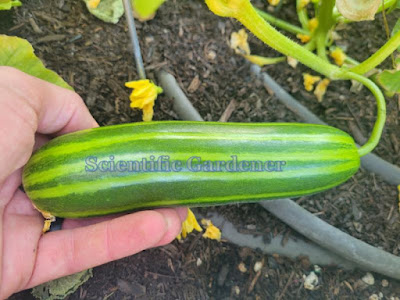While the origin of the plant species Cucumis melo is most often associated with Africa, there are also Cucumis melo varieties that are Asian in origin. Less domesticated than the African melos, the Cucumis melo variety conomon is often used in cooking or pickling due to its tendency to produce bitter fruit. Often referred to as an Asian pickling melon, these fruit tends to thrive in warm humid conditions much better than many African C. melo varieties. In general, conomons also have some unique traits that make them unique from other C. melos including a spiny stem and extremely short hair on the fruit
The Timun Krai is an Indonesian cucumber variety from the small village in East Java called Krai. While the Timun Krai is generally not bitter, occasionally one entire plant will produce extraordinarily bitter fruit. Only one of the plants I grew in 2023 produced bitter fruit. By tasting the immature fruit and flowers of all the plants, I was able to ensure that none of the seed that was saved came from a bitter fruit. The texture of the Timun Krai is very fine and nice and the flavor is quite good.
My experience growing the Timun Krai was generally pretty good. I am very grateful for a couple I met at the Solano Community College Agrictulture Club who let me utilize a space in their yard for planting. I had to replant due to cooler spring weather that extended until at least mid-May. I was probably only able to get the plants established in early June. Then I experienced some major losses due to slugs and snails. Eventually in mid-June, with most of the plants covered in fine netting, I was able to get a good stand of seedlings.
The plants grew well and watching them grow was pretty fun. The small immature fruits are both interesting to look at and very fine-textured. As they grew, I observed variations in the fruit color and profile, though the majority of the vines produced nice cylindrical fruit.
Problems arose later in the season after I had added some free city compost. Despite its beauty, the city compost did not improve plant growth. Instead, the plants began to change color and develop little spots. Eventually, these spots turned out to somehow be correlated with spider mites. Once I identified the spider mites, I vigorously sprayed the leaves. With the end of the season so close and the fruit fully set, I decided not to invest in any other natural solutions to the infestation.
After harvesting the fruit and saving them for seed, my germination was not high enough to warrant offering these seeds to anyone, so I will just have to grow them again. My general hope for the Timun Krai is that it will be a very suitable variety to grow in the Southeastern United States. I’m also interested to see how this variety does in the climate and also if it has any resistance to the pickleworm.














































No comments:
Post a Comment
Dear Gardening Friends,
I look forward to learning more about gardening with you. Your comments help me recognize that gardening is a life-long journey.
To advertisers: Note that this blog is concerned with gardening and gardening techniques. Please do not attempt to advertise here by leaving a comment. Depending upon how egregious the comment is, it may be deleted.